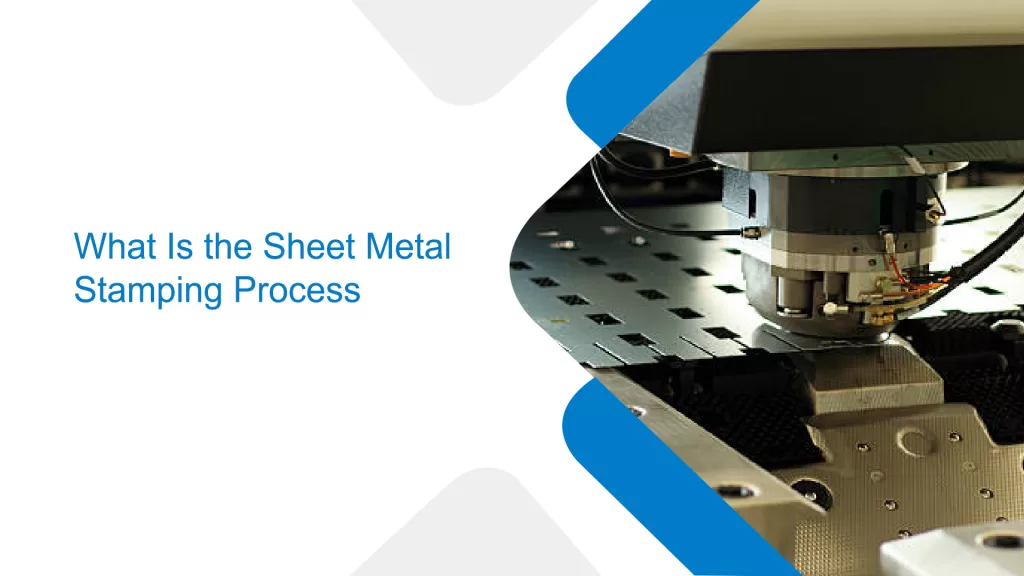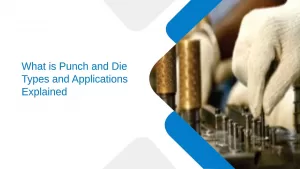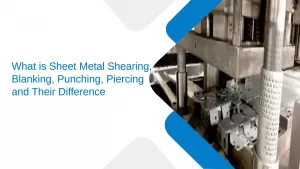What Is the Sheet Metal Stamping Process?
- Metal Stamping |
- May 8, 2025

Sheet metal stamping is a popular and effective metal forming technique. It has the potential to turn flat metal sheets into functional metal parts of different shapes and sizes. To produce complex designs and forms, the sheet metal stamping process has made a name for itself in industries like electronics and aerospace. Its cost-effectiveness and ability to deliver on a large scale are some of its best features. Here, you will learn a lot about the sheet metal stamping process and its types:
Materials Used In Metal Stamping
The metal sheet is required first for metal stamping. Various metals can be used depending on the intended application of the part. Common resources include
Steel: Steel is so strong and long-lasting. It is generally used in equipment and applications.
Copper: Copper effectively conducts electricity, and this is what makes it so famous. It is used a lot in electronics.
Brass: Brass looks attractive and is strong as well. This material is used in fittings and decorative objects.
Stainless Steel: Stainless steel is widely used because of its corrosion resistance and durability. It is often chosen for high-precision metal parts in industries that require both strength and appearance.
Primary Steps of Stamping Sheet Metal
The following are the primary steps in the sheet metal process:
Part Design
Engineers use computer software to design the component before stamping starts. They ensure the part has the correct shapes and sizes for its intended use and that it can be accurately formed using a punch and die system.
Making the Die
After the design is complete, a die is produced. Consider a die a type of specialised mould used to shape metal. To endure the high stamping pressures, dies are made of strong materials and are paired with advanced stamping machines to deliver consistent results in high-volume metal forming.
Preparing the Metal Sheet
The blank metal sheet will be ready to be stamped. Cutting the sheet to the proper size and washing it to eliminate contaminants are part of this process. The operational sheets are also called a process sheet and will provide detailed guidelines for these preparation steps. For the stamping process, big coils of metal are occasionally unrolled and sliced into manageable pieces.
Stamping the Metal
The preparation of the die and metal sheet initiates the stamping manufacturing process. The sheet of metal is placed in a stamping press, which forms it into the shape of the die with great power. To get the desired shape, the metal may be
Bent: A sheet of metal is bent in a straight line to make an angle or curve. This is used to make parts like brackets, covers, or frames that need correct angles. The punch and die used in the stamping machine make sure the bend is perfect and the same every time
Stretched: Sometimes, the sheet is stretched over a die to cover more area and be thinner. Stretching is especially useful for making smooth, curved parts like aeroplane parts or car body panels. It helps keep the metal strong and also in its shape without breaking it.
Sliced: During stamping, metal sheets can be cut to make holes, slots, or separate parts. These cutting steps use methods like blanking and piercing to ensure the final parts have clean edges and the right shapes and sizes for more work.
These steps also involve the following,
Cutting the Metal Sheet: The blanking process in sheet metal is used to cut a flat piece (blank) from a bigger sheet during this step of the process. The metal is ready for additional shaping and forming in this step.
Piercing Operation: This step creates holes or slots in the sheet metal by shearing material away. It allows the part to have attachment points or openings needed for its design.
Ensuring Precision: The piercing process in sheet metal ensures that all holes or cutouts meet precise standards, improving the part’s operation and appearance.
Trimming and Punching: It could be necessary to remove extra material after the initial stamping. Punching leaves holes or precise perforations in the metal, whereas trimming removes unnecessary edges. Through these processes, the part will be refined to fit exact specifications.
Finishing
The stamped component goes through finishing procedures to improve its look and performance. To stop rust and increase longevity, this can involve the following activities:
Cleaning: After stamping, the metal part might have grease, dirt, or small metal pieces. These are cleaned to keep the area neat and ready for the next phase.
Polishing: This process eliminates scratches or rough spots from stamping, resulting in a shiny and smooth surface. It also enhances the look of the part.
Applying protective coatings: A special layer, like paint, powder coat, or plating, is added to protect the metal from rust, scratches, or damage.
The part is prepared for its intended application through finishing.
Quality Checking
In the manufacturing process, quality control holds great value. Inspection will be done on each stamped part to ensure it satisfies the necessary dimensions and quality requirements. Doing so will provide the final product standard to meet the ongoing demand.
Read Also: An Overview of Stamping Process for Increased Productivity
Different Sheet Metal Stamping Types
Sheet metal stamping uses a variety of processes, each of which is suitable for a particular part type and production volume. Below is a brief overview of the four main types of Sheet metal stamping used in production.
Progressive Die Stamping
When many identical components are needed, progressive die stamping is one of the most widely used methods. This technique feeds a continuous metal strip through multiple stations on a single die. The metal goes through a certain process at each station, as in the following
- Cutting
- Bending
- punching
A fully formed part will be finished when the metal reaches the end of the press. Every station builds upon the one before it, which makes the procedure incredibly effective and reliable.
Transfer Die Stamping
Typically, larger or more intricate pieces requiring several forming procedures will be stamped using transfer dies. A transfer system (mechanical fingers or automation) will take the individual part from the metal strip early and from station to station. On the other hand, in progressive die stamping, the part remains attached to the strip throughout.
Every die carries out a unique function to meet the desired output as follows:
- Punching
- Drawing
- Bending
Deep Draw Stamping
Deep draw stamping produces components with a deep, hollow shape using a flat metal sheet. A metal blank is placed over a die cavity in this procedure, and the metal is then drawn into the die using a punch to stretch it into the desired shape. A component is considered “deep drawn” when its depth exceeds its diameter. Manufacturers can create parts with soft walls that are both smooth and strong because of this technique.
Four-Slide Stamping
Four-slide stamping shapes metal in many directions simultaneously using four distinct sliding tools. This technique is also known as multi-slide stamping. Four-slide presses can perform several intricate bends and cuts in a single cycle as they run horizontally, in contrast to standard presses that function vertically. This method works especially well when making complex parts with several bends or twists.
The Bottom Line
Many industries depend on the precision and effectiveness of the sheet metal stamping process. For accurate and superior metal stamping, trust Eigen Engineering. Many industries, like aerospace, rely on us because of our accuracy in delivery. Contact us now to use customised solutions to make your project a reality.
Ujjwal handles crucial roles like AGM Marketing, researcher, and is an author for KDDL – Eigen. He currently works with Eigen for implementing proven techniques and strategies for marketing plans on online and offline platforms. An expert in efficiently executing SEO, SEM, email marketing, social media marketing, PR marketing, Print campaigns, etc. Ujjwal has coordinated an efficient marketing team on various creative campaigns and programmatic buying to support various digital cross-promotion efforts. Implement efficient search optimization strategies with the help of collateral material and metrics.
In his former years, Ujjwal has years of experience in a managerial role for several reputed companies. His years of experience combined with the flair of writing help him come up with result oriented strategies for Eigen.




